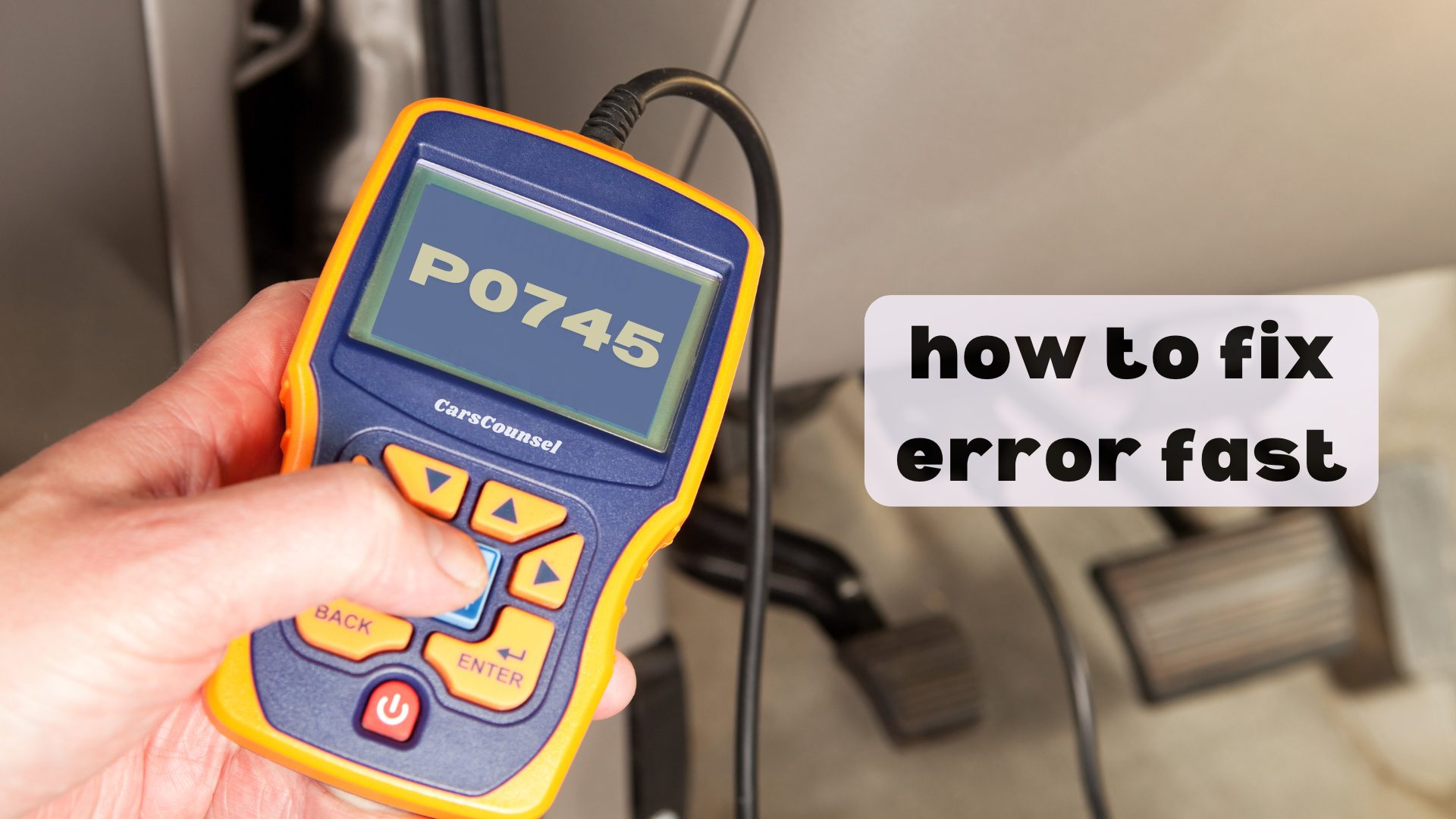Dealing with the P0745 code can be a hassle, but it’s important to fix it quickly to avoid bigger transmission problems.
First, check your transmission fluid levels and make sure the fluid is clean. Low or dirty fluid often causes this error.
Next, look at the wiring harness for any damage or wear.
Use an OBD-II scanner to confirm the error code and find any other related issues.
If the pressure control solenoid is broken, you might need to replace it.
Want to know the exact steps and costs? Let’s break it down further.

Quick Navigation
Key Takeaways
- Check transmission fluid levels: Make sure there’s enough clean transmission fluid to prevent solenoid problems.
- Inspect wiring harness: Look for any damaged or worn-out wires and fix or replace them if needed.
- Replace faulty solenoid: If the solenoid is bad, swap it out to get the hydraulic pressure working right again.
- Use an OBD-II scanner: Double-check the P0745 code and find any other transmission issues.
Understanding the P0745 Code
The P0745 code means there’s a problem with the pressure control solenoid A, which helps keep the right hydraulic pressure in your car’s automatic transmission.
Keeping your transmission in good shape is crucial to avoid big problems. This code tells you that your transmission isn’t controlling pressure well, which can lead to issues.
To fix it, first, check the transmission fluid levels and quality. Low or dirty fluid can mess up the solenoid. Using an OBD-II scanner can help find the exact problem.
Regular maintenance, like changing the fluid and checking the system, can help prevent these issues and keep your transmission running smoothly.
Taking care of it now can save you from expensive repairs later.
Symptoms of P0745 Code
If you see the P0745 code, you’ll probably notice some clear signs that something’s wrong with your car:
- Harsh Shifting: You’ll feel rough or jerky movements when the transmission changes gears.
- Slipping Gears: The vehicle might suddenly shift out of gear, causing a sudden loss of power.
- Transmission Overheating: If the transmission gets too hot, it can cause more damage if not fixed quickly.
Catching these signs early can help you avoid more serious problems and expensive repairs.
Common Causes
There are several common reasons why the P0745 code might appear. One of the main causes is a faulty solenoid valve, which messes up the hydraulic pressure needed for smooth shifting.
Dirty or contaminated transmission fluid can also be a big problem, as it can affect how well the solenoid and other parts work.
Issues with wiring, like broken or frayed wires, can disrupt the solenoid’s function as well.
Low transmission fluid levels can also cause this code to pop up because there isn’t enough fluid for the solenoid to work properly.
Lastly, a bad transmission control module (TCM) could be the culprit, impacting the whole system’s performance.
Each of these issues needs to be diagnosed and fixed quickly to avoid more damage.
Affected Car Models
Affected Car Models
Some cars are more likely to have issues with the P0745 code, which indicates problems with the pressure control solenoid in the transmission. Knowing which cars are affected can help you prepare for potential issues.
Here are some cars that often have this problem:
- Nissan Altima: Models from 2002 to 2016
- Honda Accord: Models from 1998 to 2007
- Toyota Corolla: Models from 2009 to 2013
Initial Diagnostic Steps
To fix issues with the P0745 code, start by checking the transmission fluid levels since low fluid is often the problem.
Then, look at the wiring harness to see if there are any signs of wear, damage, or disconnection.
Use an OBD-II scanner to read the error codes and confirm the P0745 code.
Perform a transmission pressure test to check the hydraulic pressure; if there are issues here, it could point to solenoid problems.
If these steps don’t solve the problem, get help from a professional mechanic.
They can run more detailed tests, like checking the transmission control module (TCM) and looking for internal transmission damage.
Following these steps carefully will ensure you diagnose and fix the P0745 code properly.
Checking Fluid Levels
First, make sure you check the transmission fluid levels because not having enough fluid can really affect how well the solenoid works.
Keeping an eye on your fluid is crucial for your transmission system. Start by making sure your car is on a flat surface and the engine is warm. Use the dipstick to check how much fluid is in there and what it looks like. Remember to use the right type of fluid as recommended by your car’s manufacturer.
- Look at the fluid color: Good fluid is usually red or pink.
- Check for dirt: See if there are any dirt, metal bits, or a burnt smell.
- Add fluid if needed: Put in the right type of transmission fluid if the level is low.
Inspecting Wiring Harness
Check the wiring harness for any signs of wear or damage, as bad wires can mess up the solenoid’s function and cause the P0745 code.
Start by looking at the wiring harness to see if there are any frayed, broken, or corroded wires. Pay extra attention to the solenoid connections to make sure they’re secure and clean.
Use a multimeter to check if the wires have a good connection; any breaks or shorts might be the problem. Regularly checking the wiring can help prevent these issues.
If you find any damaged wires, fix or replace them right away. Keeping the wiring harness in good shape can stop electrical problems that could make the solenoid fail, helping you fix the P0745 code more easily.
Transmission Pressure Test
After making sure the wiring harness is in good shape, you should do a transmission pressure test. This will help check if the hydraulic system is working properly and find any pressure issues that might affect the solenoid.
Here’s how to do the test correctly:
- Connect a pressure gauge: Attach it to the right port on the transmission.
- Start the engine: Let it idle and keep an eye on the gauge readings.
- Compare readings: Check if the pressures match what the manufacturer says they should be.
Using an OBD-II Scanner
To figure out the P0745 code, you need to use an OBD-II scanner to read the error codes stored in your car’s computer.
An OBD-II scanner helps you quickly and accurately find issues without guessing. There are different types of scanners, from simple ones that just read codes to advanced ones that give detailed data and real-time monitoring.
By connecting the scanner to your car’s OBD-II port, you can find the P0745 code and any related codes, which will help you understand what’s wrong.
This is important for fixing transmission problems and preventing more damage.
Repair Options and Costs
Fixing the P0745 code can involve different repairs with costs that vary based on the problem and the type of vehicle. Here’s a simple breakdown to help you understand what you might spend and how to prevent it:
- Replace the bad solenoid: This can cost between $200 to $500.
- Add transmission fluid: If the fluid is low, you can do this yourself for a low cost.
- Flush out dirty fluid: A professional should do this, and it usually costs around $150 to $300.
To prevent this issue, do regular maintenance like checking fluid levels, using good quality transmission fluid, and fixing problems as soon as they pop up. Following these steps can help you avoid seeing the P0745 code again.
More OBD-II Codes
Frequently Asked Questions
How Does the Pressure Control Solenoid Function in an Automatic Transmission?
The pressure control solenoid helps manage the hydraulic pressure in your automatic transmission. It adjusts the fluid pressure to make sure the gears shift smoothly. If it stops working properly, the pressure won’t be regulated correctly, causing the gears to shift unpredictably and possibly damaging the transmission.
What Are the Risks of Driving With the P0745 Code?
Driving with the P0745 code can seriously damage your transmission. You might notice rough shifting and slipping gears. Ignoring these problems could cause your transmission to fail completely, leading to expensive repairs or even needing a whole new transmission.
Can Aftermarket Transmission Components Affect the Likelihood of a P0745 Code?
Yes, using aftermarket parts can increase the chances of getting a P0745 code. Make sure the solenoid is compatible with your vehicle’s transmission to avoid problems that could trigger this error and cause more issues.
Are There Any Specific Driving Habits That Can Prevent a P0745 Code?
To stop the problem early, try to accelerate and brake smoothly. Regular maintenance, like checking fluid levels and changing fluids on time, along with gentle driving, can help prevent the P0745 code from showing up.
How Often Should Transmission Fluid Be Changed to Avoid Solenoid Issues?
To avoid problems with the solenoid, you should regularly maintain your transmission. Change the transmission fluid every 30,000 to 60,000 miles, or follow your manufacturer’s guidelines. Regular fluid changes ensure smooth operation and help prevent issues.
Conclusion
To sum up, fixing the P0745 code isn’t that hard if you act quickly.
Start by checking your transmission fluid and looking over the wiring.
Use an OBD-II scanner to find the exact problem.
If it’s the pressure control solenoid, replacing it can save you a lot of money later.
Regular maintenance helps prevent these issues.
Follow these steps, and your car will be running smoothly again!

